Effect of intercalated cell-specific Rh C glycoprotein deletion on basal and metabolic acidosis-stimulated renal ammonia excretion
- PMID: 20462967
- PMCID: PMC2928528
- DOI: 10.1152/ajprenal.00120.2010
Effect of intercalated cell-specific Rh C glycoprotein deletion on basal and metabolic acidosis-stimulated renal ammonia excretion
Abstract
Rh C glycoprotein (Rhcg) is an NH(3)-specific transporter expressed in both intercalated cells (IC) and principal cells (PC) in the renal collecting duct. Recent studies show that deletion of Rhcg from both intercalated and principal cells inhibits both basal and acidosis-stimulated renal ammonia excretion. The purpose of the current studies was to better understand the specific role of Rhcg expression in intercalated cells in basal and metabolic acidosis-stimulated renal ammonia excretion. We generated mice with intercalated cell-specific Rhcg deletion (IC-Rhcg-KO) using Cre-loxP techniques; control (C) mice were floxed Rhcg but Cre negative. Under basal conditions, IC-Rhcg-KO and C mice excreted urine with similar ammonia content and pH. Mice were then acid loaded by adding HCl to their diet. Ammonia excretion after acid loading increased similarly in IC-Rhcg-KO and C mice during the first 2 days of acid loading but on day 3 was significantly less in IC-Rhcg-KO than in C mice. During the first 2 days of acid loading, urine was significantly more acidic in IC-Rhcg-KO mice than in C mice; there was no difference on day 3. In IC-Rhcg-KO mice, acid loading increased principal cell Rhcg expression in both the cortex and outer medulla as well as expression of another ammonia transporter, Rh glycoprotein B (Rhbg), in principal cells in the outer medulla. We conclude that 1) Rhcg expression in intercalated cells is necessary for the normal renal response to metabolic acidosis; 2) principal cell Rhcg contributes to both basal and acidosis-stimulated ammonia excretion; and 3) adaptations in Rhbg expression occur in response to acid-loading.
Figures


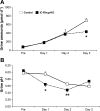
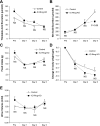

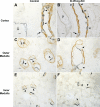

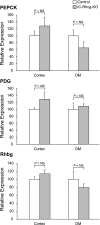
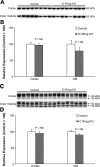

Similar articles
-
Effect of collecting duct-specific deletion of both Rh B Glycoprotein (Rhbg) and Rh C Glycoprotein (Rhcg) on renal response to metabolic acidosis.Am J Physiol Renal Physiol. 2014 Feb 15;306(4):F389-400. doi: 10.1152/ajprenal.00176.2013. Epub 2013 Dec 11. Am J Physiol Renal Physiol. 2014. PMID: 24338819 Free PMC article.
-
Role of the Rhesus glycoprotein, Rh B glycoprotein, in renal ammonia excretion.Am J Physiol Renal Physiol. 2010 Nov;299(5):F1065-77. doi: 10.1152/ajprenal.00277.2010. Epub 2010 Aug 18. Am J Physiol Renal Physiol. 2010. PMID: 20719974 Free PMC article.
-
Collecting duct-specific Rh C glycoprotein deletion alters basal and acidosis-stimulated renal ammonia excretion.Am J Physiol Renal Physiol. 2009 Jun;296(6):F1364-75. doi: 10.1152/ajprenal.90667.2008. Epub 2009 Mar 25. Am J Physiol Renal Physiol. 2009. PMID: 19321595 Free PMC article.
-
Renal and hepatic expression of the ammonium transporter proteins, Rh B Glycoprotein and Rh C Glycoprotein.Acta Physiol Scand. 2003 Dec;179(4):331-8. doi: 10.1046/j.0001-6772.2003.01210.x. Acta Physiol Scand. 2003. PMID: 14656370 Review.
-
The rhesus protein RhCG: a new perspective in ammonium transport and distal urinary acidification.Kidney Int. 2011 Jan;79(2):154-61. doi: 10.1038/ki.2010.386. Epub 2010 Oct 6. Kidney Int. 2011. PMID: 20927037 Review.
Cited by
-
Role of NH3 and NH4+ transporters in renal acid-base transport.Am J Physiol Renal Physiol. 2011 Jan;300(1):F11-23. doi: 10.1152/ajprenal.00554.2010. Epub 2010 Nov 3. Am J Physiol Renal Physiol. 2011. PMID: 21048022 Free PMC article. Review.
-
Ammonia transport in the kidney by Rhesus glycoproteins.Am J Physiol Renal Physiol. 2014 May 15;306(10):F1107-20. doi: 10.1152/ajprenal.00013.2014. Epub 2014 Mar 19. Am J Physiol Renal Physiol. 2014. PMID: 24647713 Free PMC article. Review.
-
Effects of chronic lithium administration on renal acid excretion in humans and rats.Physiol Rep. 2014 Dec 11;2(12):e12242. doi: 10.14814/phy2.12242. Print 2014 Dec 1. Physiol Rep. 2014. PMID: 25501430 Free PMC article.
-
Renal ammonia excretion in response to hypokalemia: effect of collecting duct-specific Rh C glycoprotein deletion.Am J Physiol Renal Physiol. 2013 Feb 15;304(4):F410-21. doi: 10.1152/ajprenal.00300.2012. Epub 2012 Nov 28. Am J Physiol Renal Physiol. 2013. PMID: 23195675 Free PMC article.
-
The proximal tubule through an NBCe1-dependent mechanism regulates collecting duct phenotypic and remodeling responses to acidosis.Am J Physiol Renal Physiol. 2023 Jan 1;324(1):F12-F29. doi: 10.1152/ajprenal.00175.2022. Epub 2022 Oct 20. Am J Physiol Renal Physiol. 2023. PMID: 36264886 Free PMC article.
References
-
- Biver S, Belge H, Bourgeois S, Van Vooren P, Nowik M, Scohy S, Houillier P, Szpirer J, Szpirer C, Wagner CA, Devuyst O, Marini AM. A role for Rhesus factor Rhcg in renal ammonium excretion and male fertility. Nature 456: 339–343, 2008 - PubMed
-
- Chambrey R, Goossens D, Bourgeois S, Picard N, Bloch-Faure M, Leviel F, Geoffroy V, Cambillau M, Colin Y, Paillard M, Houillier P, Cartron JP, Eladari D. Genetic ablation of Rhbg in mouse does not impair renal ammonium excretion. Am J Physiol Renal Physiol 289: F1281–F1290, 2005 - PubMed
-
- Conjard A, Komaty O, Delage H, Boghossian M, Martin M, Ferrier B, Baverel G. Inhibition of glutamine synthetase in the mouse kidney: a novel mechanism of adaptation to metabolic acidosis. J Biol Chem 278: 38159–38166, 2003 - PubMed
-
- Eladari D, Cheval L, Quentin F, Bertrand O, Mouro I, Cherif-Zahar B, Cartron JP, Paillard M, Doucet A, Chambrey R. Expression of RhCG, a new putative NH3/NH4+ transporter, along the rat nephron. J Am Soc Nephrol 13: 1999–2008, 2002 - PubMed
Publication types
MeSH terms
Substances
Grants and funding
LinkOut - more resources
Full Text Sources
Molecular Biology Databases
Research Materials

